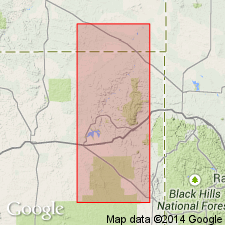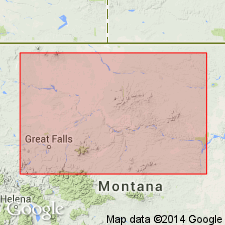
- Usage in publication:
-
- Beaver Creek chalky member*
- Modifications:
-
- Original reference
- Dominant lithology:
-
- Marl
- Siltstone
- AAPG geologic province:
-
- Powder River basin
- Williston basin
Summary:
Beaver Creek chalky member of Niobrara formation. Chalk marl and calcareous siltstone, gray where fresh; weathers to light yellow. Marine fossils. Thickness 125 to 200 feet. Upper member of Niobrara formation. Overlies Sage Breaks shale member of Niobrara. Age is Late Cretaceous.
Named from exposures along Beaver Creek, in T. 46 N., R. 64 W., Weston Co., northeastern WY. Extends into southeastern MT.
Source: US geologic names lexicon (USGS Bull. 896, p. 139).

- Usage in publication:
-
- Beaver Creek chalky member*†
- Modifications:
-
- Abandoned
Summary:
Name abandoned in northern Black Hills region in Williston and Powder River basins. Name synonymous with Niobrara formation, and therefore made superfluous by reassignment of Sage Breaks member to underlying Carlile shale.
Source: GNU records (USGS DDS-6; Denver GNULEX).
For more information, please contact Nancy Stamm, Geologic Names Committee Secretary.
Asterisk (*) indicates published by U.S. Geological Survey authors.
"No current usage" (†) implies that a name has been abandoned or has fallen into disuse. Former usage and, if known, replacement name given in parentheses ( ).
Slash (/) indicates name conflicts with nomenclatural guidelines (CSN, 1933; ACSN, 1961, 1970; NACSN, 1983, 2005, 2021). May be explained within brackets ([ ]).

